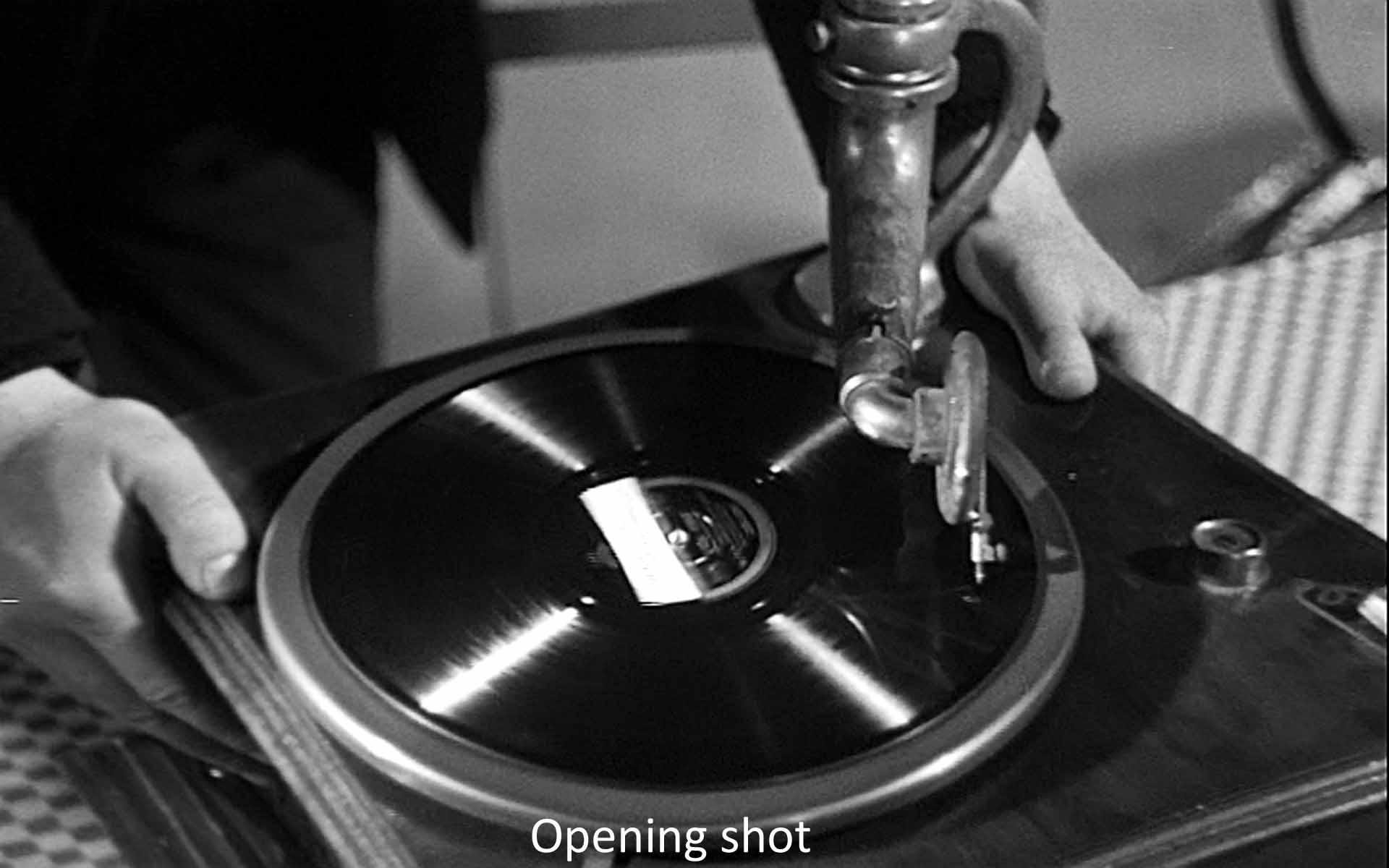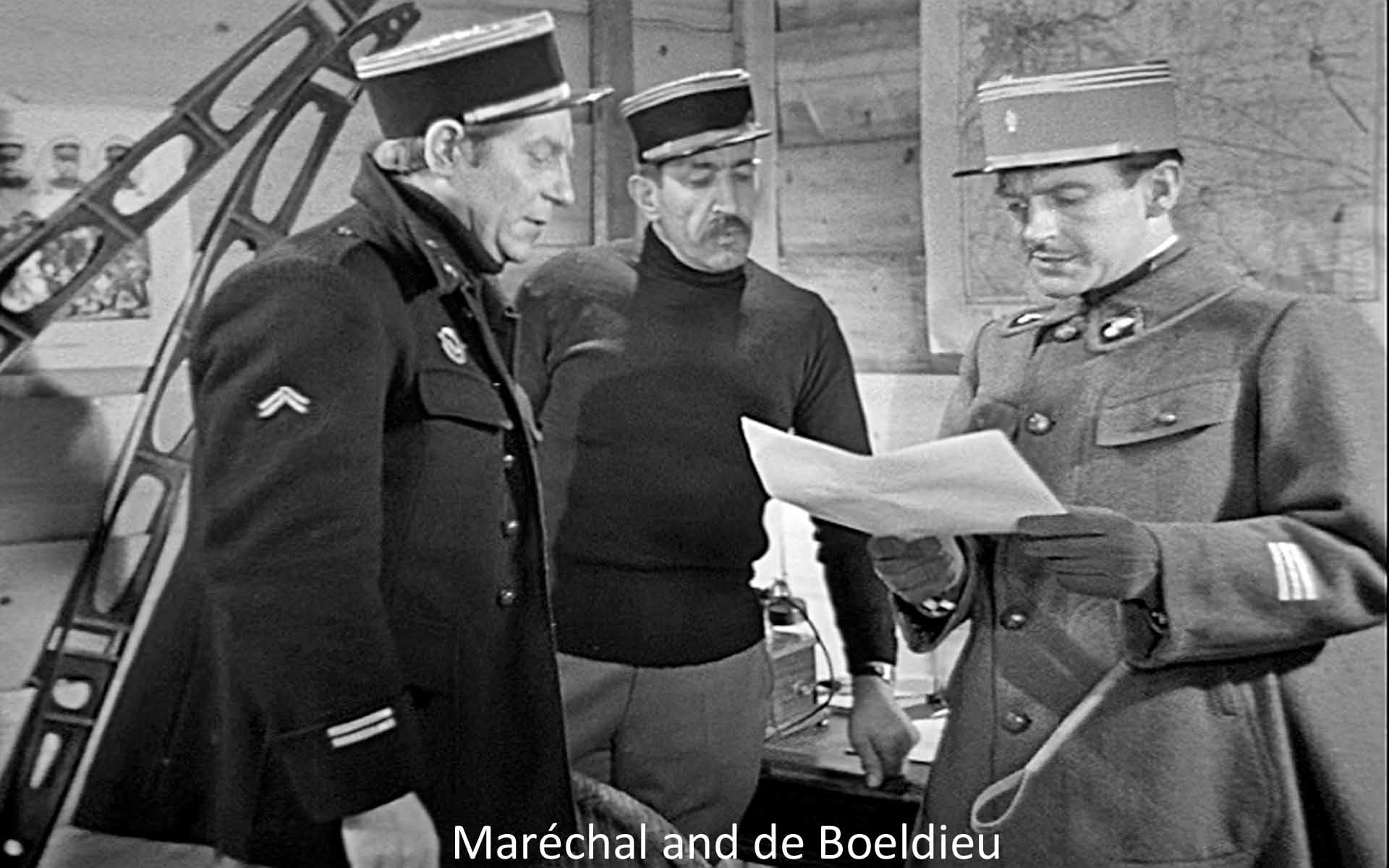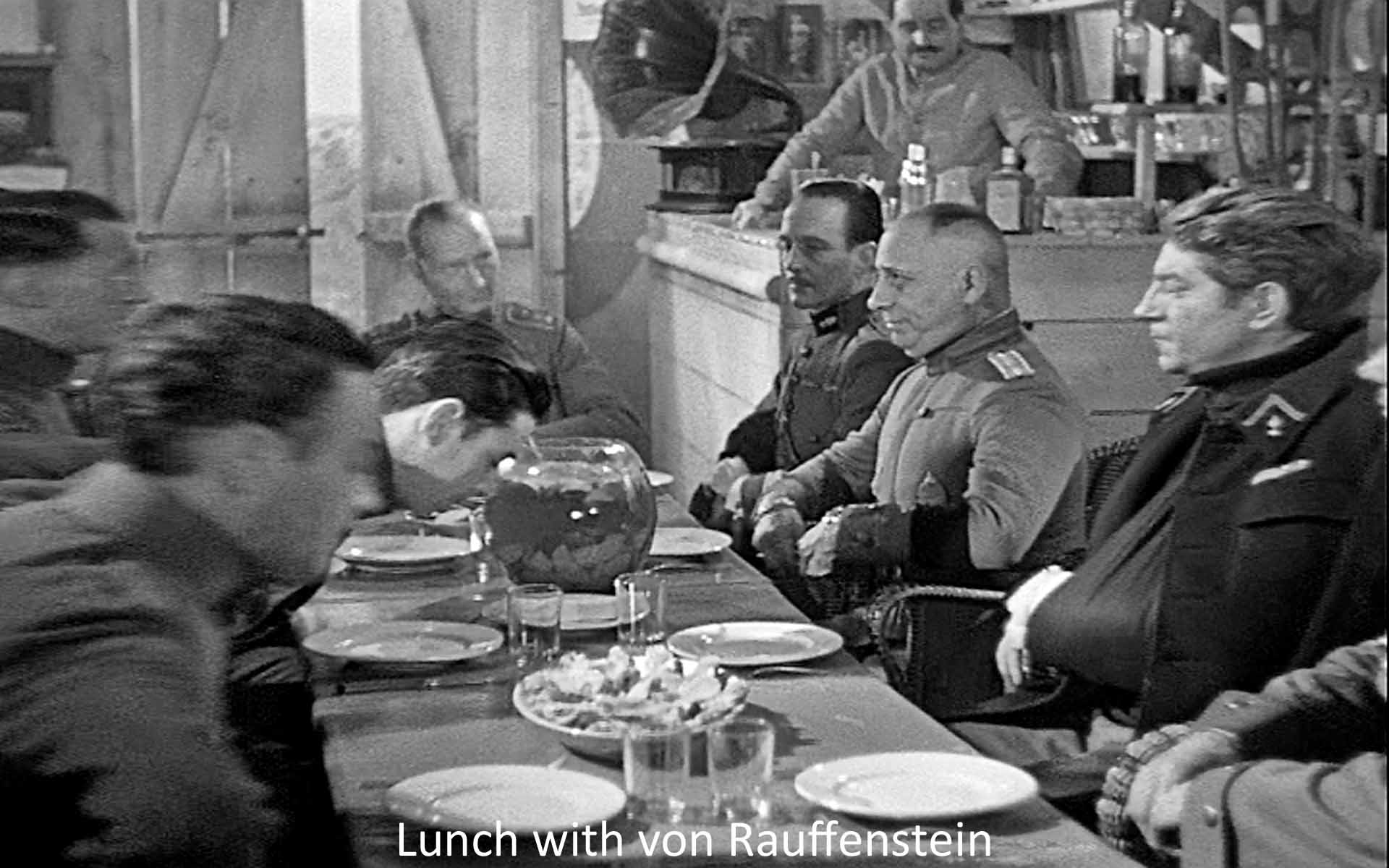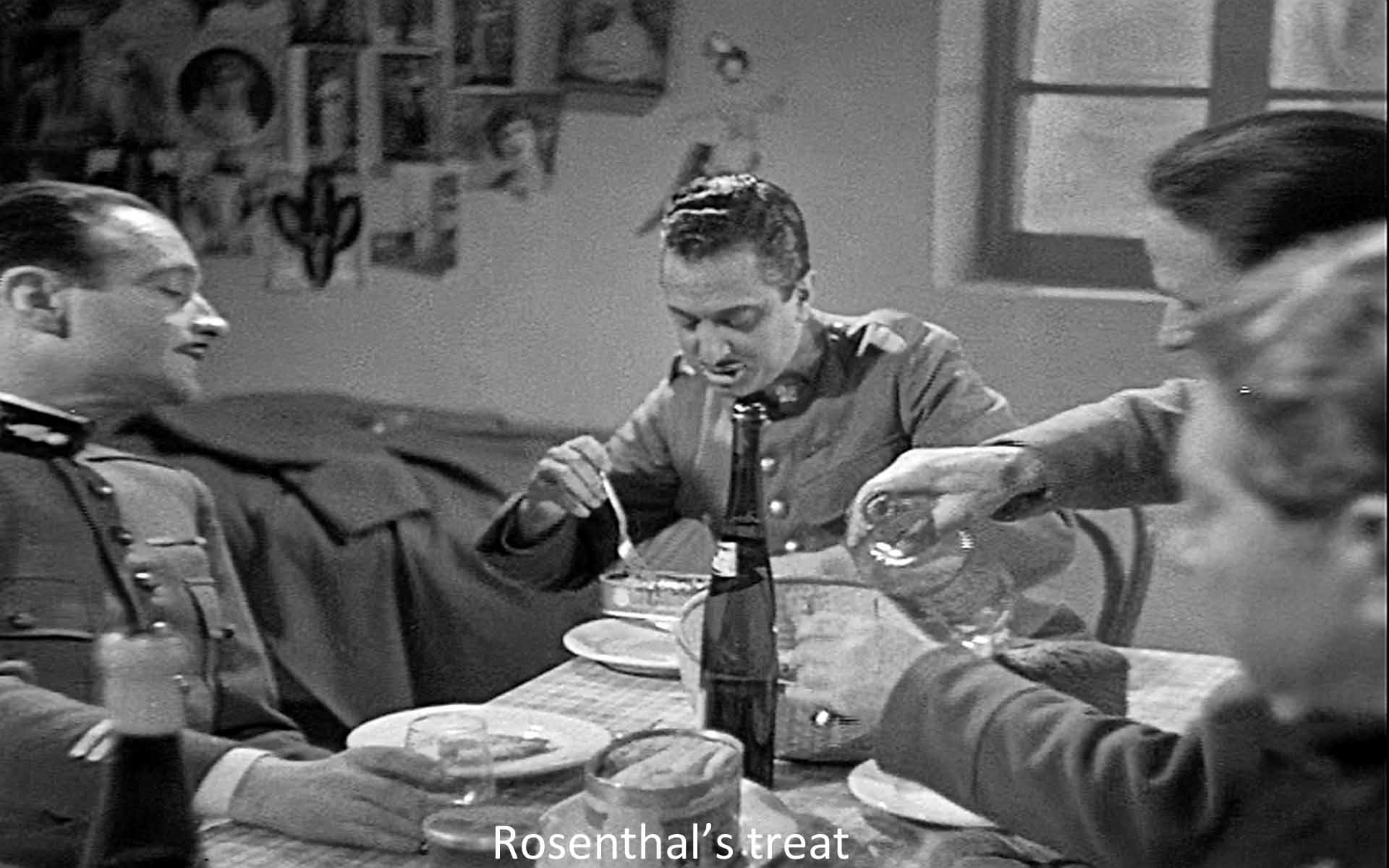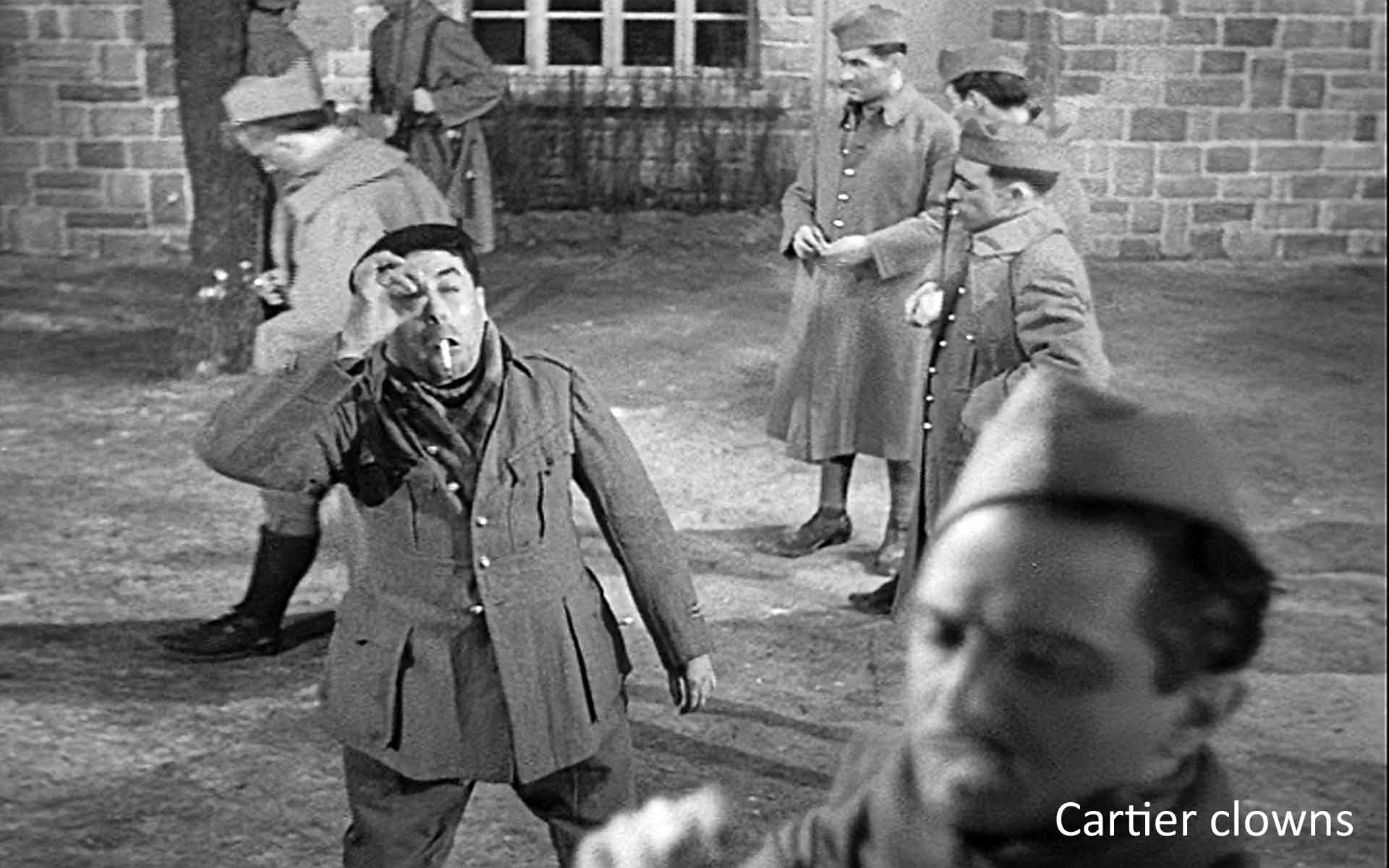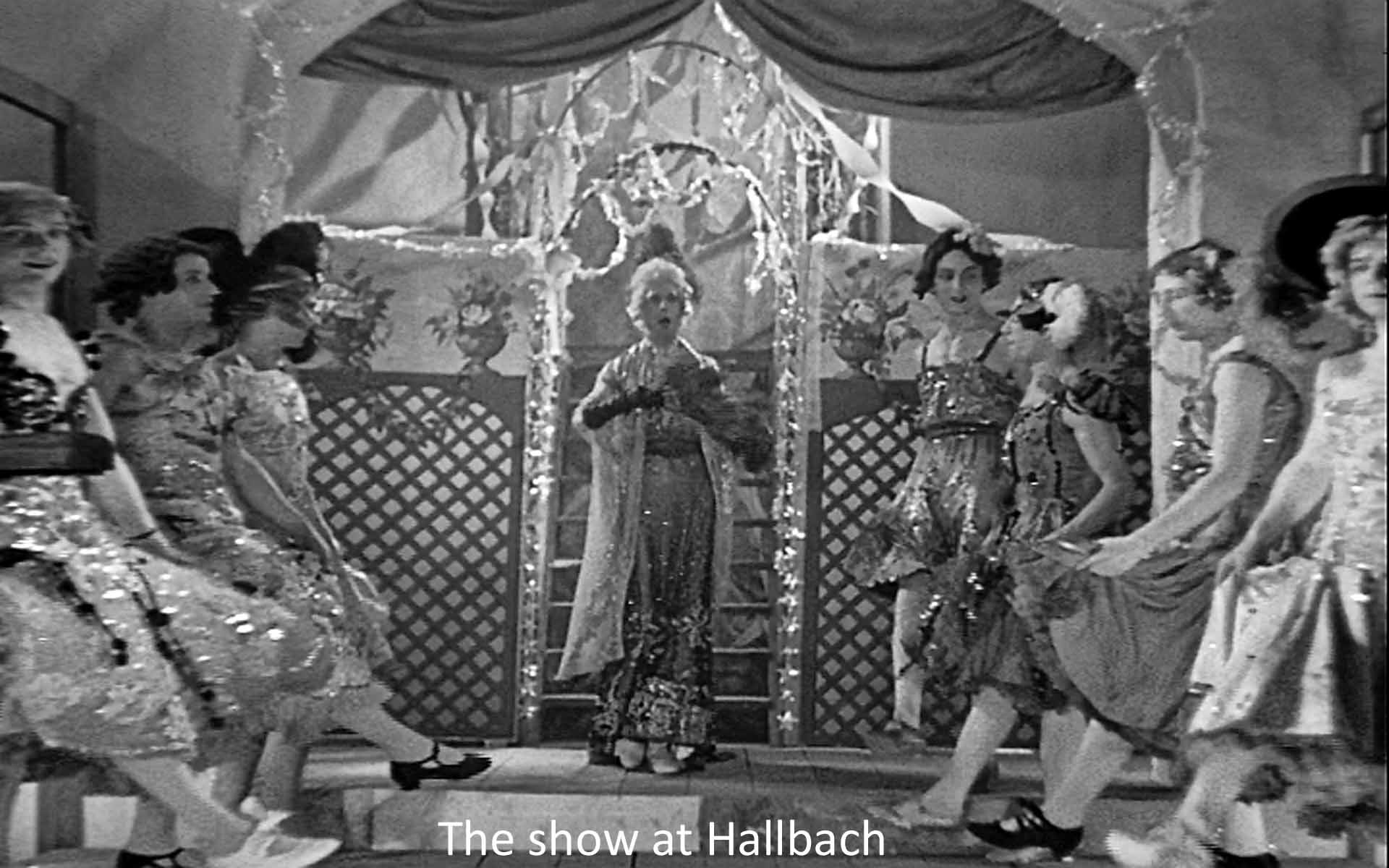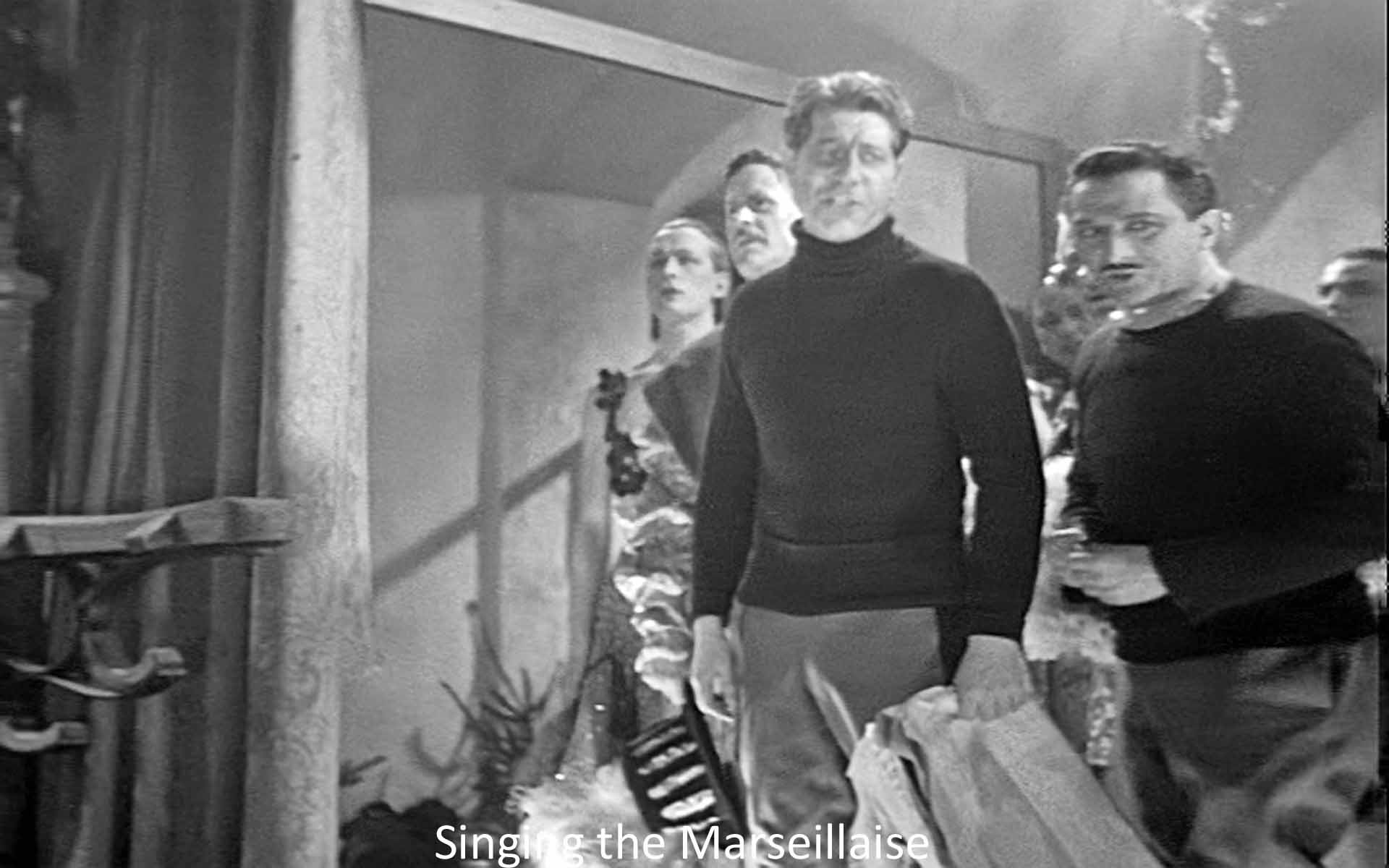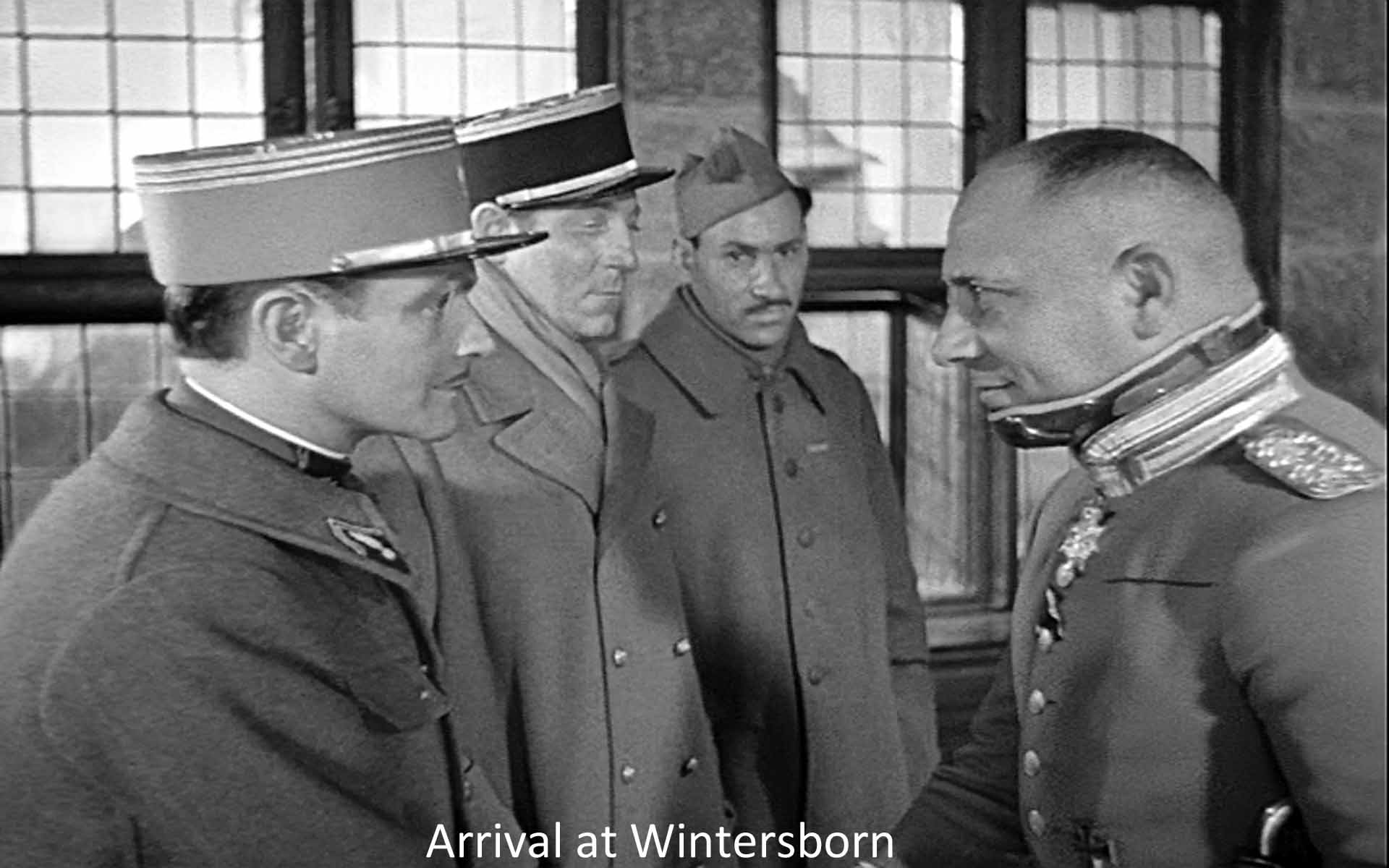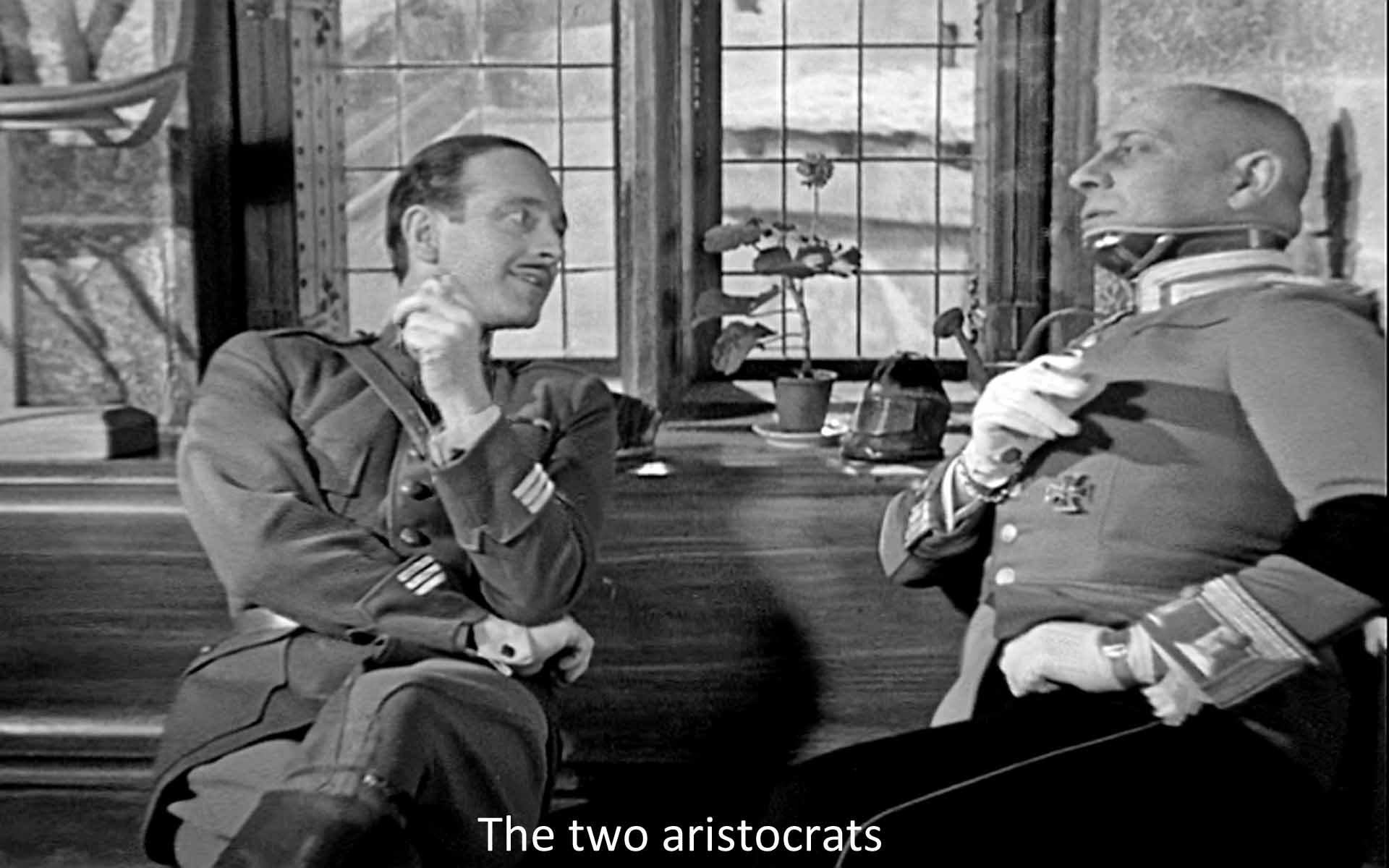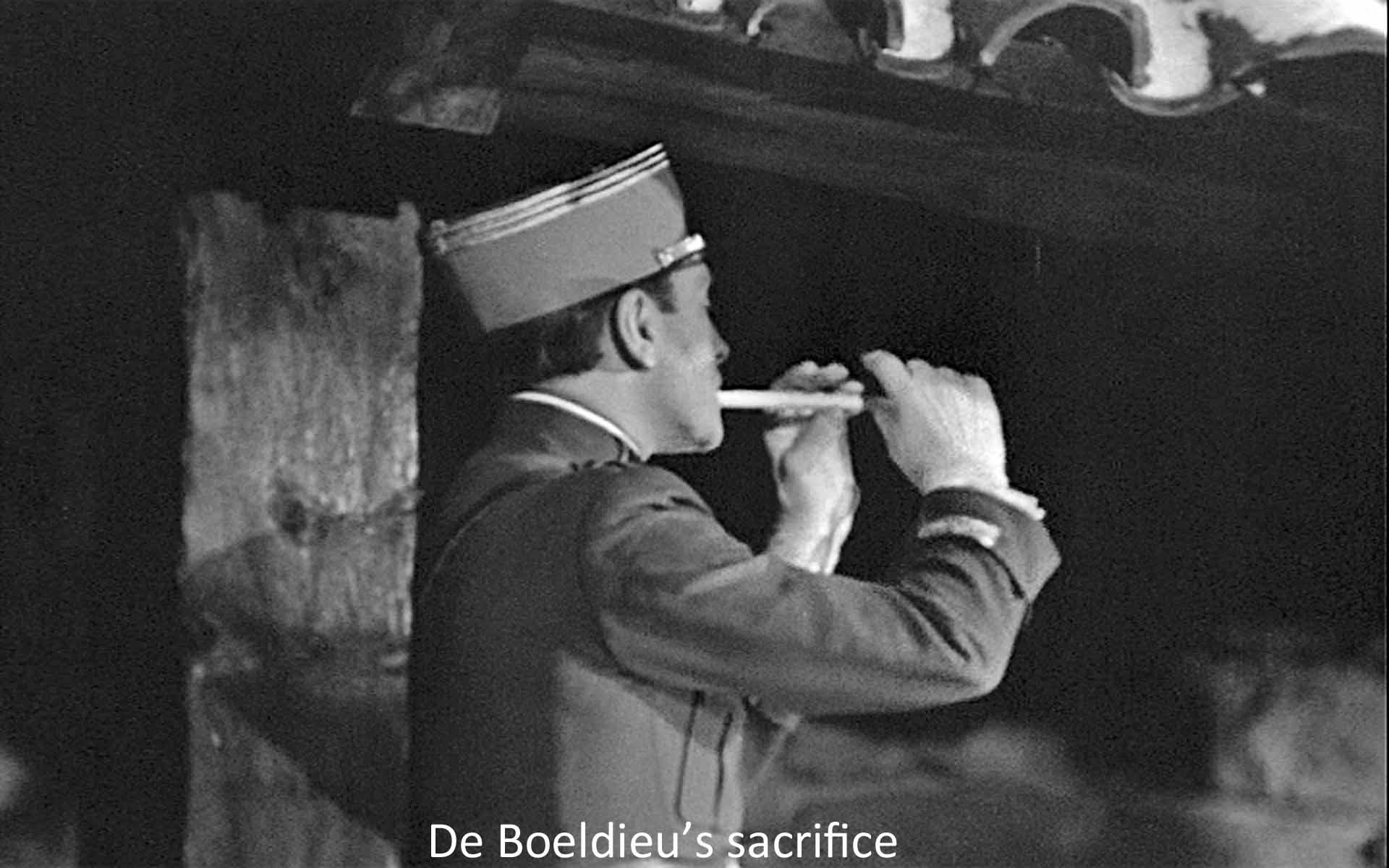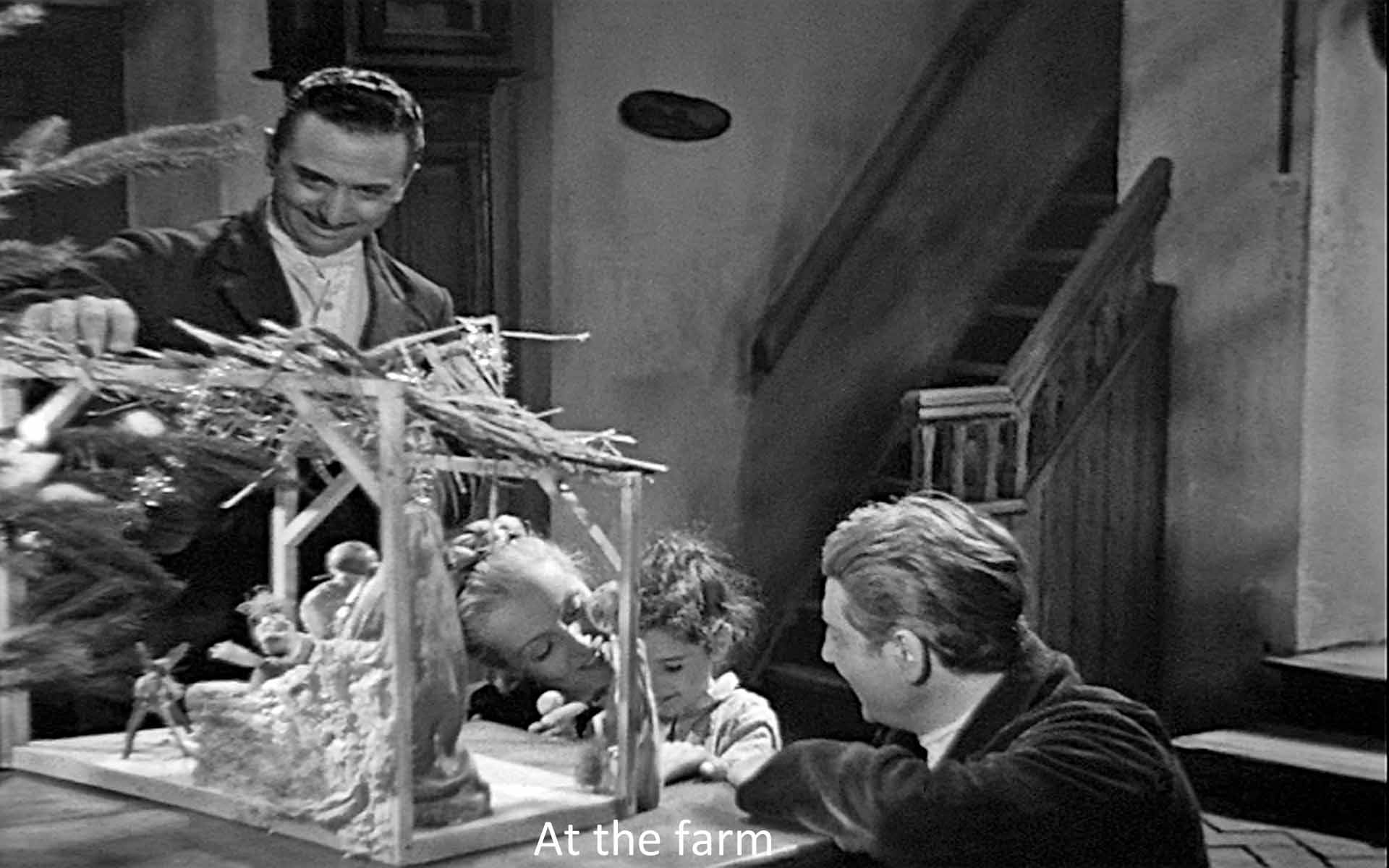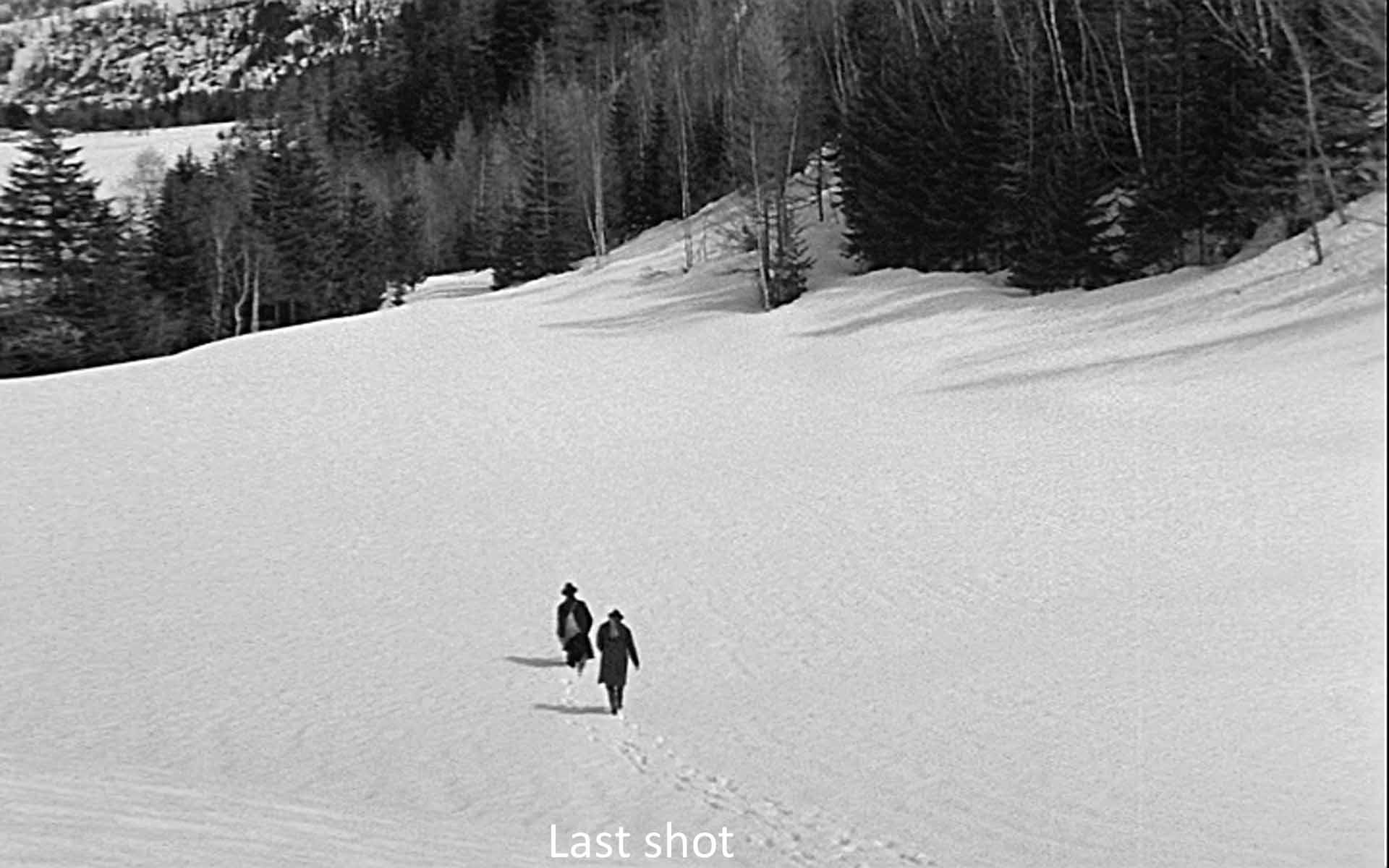People often call La Grande Illusion an anti-war movie, and so it is. But Renoir himself said, “My chief aim was the one which I have been pursuing ever since I started: to make films to express the common humanity of men” (148).
Is that why the plot is so simple? Renoir even called it “banal.” Maréchal (Jean Gabin), formerly a mechanic, now a fighter pilot, takes the aristocratic Captain de Boeldieu (Pierre Fresnay) up. They are shot down and captured by especially gallant Germans, led by Captain von Rauffenstein (Erich von Stroheim). De Boeldieu and Maréchal are taken to a POW camp where they become part of a group of French officer prisoners, notably Cartier (Julien Carette), an irrepressible music-hall comic, and Rosenthal (Marcel Dalio), a wealthy Jew whose food parcels from home delight the prisoners. In the best POW tradition, the group is digging a tunnel, but they are transferred to another camp before they can use it. Eventually, Boeldieu, Maréchal, and Rosenthal end up at Wintersborn, a castle converted to hold POWs who have made multiple attempts at escape. Von Rauffenstein is the commandant, his wounds having made him unfit for active duty. De Boeldieu gallantly creates a diversion—he taunts the guards by playing a flute—so that Maréchal and Rosenthal can slide down a rope and escape. After hardships, they end up at a lonely farmhouse, where Elsa (Dita Parlo) and her four-year-old daughter live. Her husband and brothers having been killed, she puts the two escapees up. Maréchal becomes her lover, but he and Rosenthal have to go. They cross over into Switzerland, planning to return to the fight, pledging to make this the war to end all wars, and Maréchal vows to return to Elsa when the war is over.
The plot is the standard one for POW movies, here based on the escapes of a friend of Renoir’s. As Boeldieu says, “A golf course is for golf. A tennis court for tennis. A prison camp for escape.” Renoir would agree: “My story was a banal one of escape. I maintain that the more banal the subject of a film, the greater are the possibilities it offers to the film-maker” (145). If banal, why then do the critics all rate this film a masterpiece?
Think about a table. What could be more banal? The first scene, in the officers’ mess, has several tables. Then, when Maréchal and Boeldieu are captured there is the table in the German officers’ mess at which both French and Germans sit. Later, in Wintersborn, the professor-prisoner wants more space at the table Boeldieu has taken over. Finally, Elsa notes that the table in her house is too big, now that all her men have been killed. A table both separates the people sitting at it and joins them.
Or think about ropes. The film has two: the rope tied to Cartier to pull him out if he gets in danger digging the tunnel in the first POW camp; the rope hidden by Boeldieu by which Rosenthal and Maréchal escape from Wintersborn. A rope connects the people at either end at the same time that it marks their separation.
But doesn’t every movie have things like tables and ropes? Why read them as developing some complicated paradoxical theme? Because Renoir has sensitized us. The third scene is key. In it von Rauffenstein graciously entertains his French prisoners in the best chivalric tradition. The action and dialogue make loud and clear the theme of difference, class difference, nationality difference, rank difference, language difference. And sameness: these men are all pilots who share the challenges and gallantries of aerial dogfighting. They share the air, so to speak. Von Rauffenstein sees them as fighting in an aristocratic tradition of one-on-one knightly combat going back to medieval times. They are comrades even if on different sides in a war, war being another thing that both separates and unites human beings.
So with social class. The von and de in de Boeldieu and von Rauffenstein mark them as aristocrats, the same in lifestyle despite different nationalities and different sides in a war. Von Rauffenstein and de Boeldieu are “enemies” but share an aristocratic tradition that sets them apart from, say, Maréchal. Were de Boeldieu to ally with von Rauffenstein as a fellow aristocrat, however, he would have to separate himself from his fellow-officers the plebeian Maréchal and the classless Rosenthal. And de Boeldieu sacrifices himself for them in an almost casual gesture (an aristocratic sprezzatura) so that they can escape. Social class is paradoxical: it unites because it divides and divides because it unites.
In that third scene, Renoir has focused us on people’s being united and being separated by war, by nationality, by social class, by language. And a table, especially sitting at a table and eating, makes these relationships visible. As a result of Renoir’s big theme, human dynamics, ordinary things like tables and ropes take on an aura of meaning. If we are seeing, really seeing, the movie, we will find ourselves seeing “banal” things like tables and ropes and escapes and all the comings and goings in this film as representing the interacting unions and separations that make up human relationships. And that is the magic of this magical film.
In a trailer (on the Criterion DVD) for the film’s release in 1958, Renoir says, La Grande Illusion is “a story about human relationships.” Pursuing that theme Renoir turns everyday elements in the film into dramatizings of humans’ sameness and difference or separation and union. For instance, people are constantly entering and exiting in this film.
Languages—sometimes they are barriers: the French prisoners cannot tell the arriving English prisoners about their tunnel. Maréchal shouts in solitary confinement, “I want to hear French spoken.” Sometimes languages are barriers to be crossed: the Russian prisoner teaches his language to the French. Elsa and Maréchal have to understand each other intuitively, because neither understands the other’s language. The aristocrats use language as both barrier and crossed barrier. Von Rauffenstein speaks English to de Boeldieu when he wants others not to hear. He is demonstrating the aristocratic education and heritage that they share and that the ordinary prisoners and soldiers do not. Renoir even acknowledges his audience’s linguistic limitations: he is almost unique in letting his actors use the characters’ original language (because he so prizes the way the voice communicates emotions). But he provided subtitles for us.
Religion: there are various acts like sacraments that remind us of a religious tradition: the surveyor washing Maréchal’s feet; de Boeldieu washing his hands in a basin before his self-sacrifice; de Boeldieu receiving last rites; Maréchal eating an apple before making love to Elsa. Especially there is the crèche at Elsa’s Christmas. The crèche brings in even Jewish Rosenthal who is excluded from the “Christian” or “French” grouping. Maréchal’s sex with Elsa follows images of the Holy Family. It is almost a sacramental act. By contrast, von Rauffenstein lives (like a consecrated knight) in a chapel with a huge crucifix dominating the room.
He represents another theme: separateness. His wounds have cut him off from his comrade pilots. In this film about relationships, the worst punishment is solitary confinement. It almost drives Maréchal crazy. A solitary escapee gets shot behind the garden. De Boeldieu acts alone and is killed for it. The two professor-prisoners make themselves silly by their “difference.” The aristocrats act alone, differently from everybody else. Their gloves reduce their contact with the rest.
Von Rauffenstein is associated with an isolated castle on a mountain. Much of the incidental imagery of the film, the walls, barbed wire, security, and especially war, separate humans from one another. But these things also create new unities of prisoners and guards. Only von Rauffenstein remains magnificently single.
Yet even he has pictures of women on the walls of his room. The movie begins and ends with “the feminine.” It opens with frou-frou and Maréchal’s smirks about Josephine. Later, the prisoners are hushed by the feel and sound of women’s clothes (frou-frou) and by seeing a “girl” after all those months. The prisoners put pictures of women up on their walls (is this a way of saying that the wish to get through those walls is like a sexual longing?). Elsa has pictures of men up on her walls. Finally, the ultimate human relationship in the film is between Maréchal and Elsa, real love, apparently, and apparently to be continued when the war ends and the barriers come down.
As in any good movie, the opening and close establish the themes. Here, the opening image is a phonograph record playing a popular song ”Frou-frou,” a French word signifying the sound of silks, lingerie for example, and lingerie both draws the lover in and keeps him out. But there is a lot of music in this film. The British soldiers sing “Tipperary,” and all the prisoners sing the Marseillaise in defiance of their German captors. A kindly guard gives Maréchal a harmonica to keep him from going crazy in solitary. Three times a squad of German soldiers sings as they march. There is the “concert” of flutes that prepares for the escape. Music signifies unity among people. Thus Maréchal and Rosenthal first sing when they try to separate. They sing “Le Petit Navire,” the same tune that de Boeldieu played on his tin flute. Incidentally, an early script called him Bois le dieu, god of the woods, Pan—a reason for his using the flute (and a reminder of similar fluting in Renoir’s earlier film, Boudu sauvé des eaux). Maréchal and Rosenthal first sing when they try to separate and then the song brings them back together. Their two tiny figures in the snow in the last shot echo the duality of frou-frou in the opening. They are united but separate.
Renoir’s camera work carries out the same inclusiveness, much like Rauffenstein’s showing his prisoners round his castle. Typical is the camera during the singing of the “Marseillaise.” In this the most stirring moment of the movie but throughout, Renoir uses long sweeping pans and dollies to cover whole ranks and roomfuls of people at once, to scoop them all up together onto the film. To go from one actor or action to another he would rather pan than cut. He photographs through doors and windows to try to bring the outer world inside. He pans to include what is outside the film frame. It is as though his camera seeks to pull things into the frame, into the very union that is the film’s theme. Critics have called it a “bear-hug” camera.
James Leahy has a highly intelligent essay in which he suggests that a Renoir film typically combines two seemingly different kinds of cinema: “popular cinema—structured to fulfill the audience’s desire for visual pleasure, the satisfactions of narrative, identification and emotional gratification; and ‘art’ cinema structured for an audience desiring ‘serious’ themes and the revelation of carefully constructed characters and their motivations from details of their dialogue and behaviour.” That is, one could experience this film in terms of, What comes next? Will the tunnel succeed? Will the rope hold? Will Maréchal and Rosenthal get to Switzerland? Does Maréchal really love Elsa? Or you can understand the characters, the images, the plot, and so on as all symphonically developing a core paradox of human relationships, that union creates separation and separation creates union. These ideas of human union and separation so permeate the film that it charges even the most “banal” of objects and actions with an aura of significance. That kind of understanding is what I have tried to work up here, and one could hardly do less for this magnificent film.
